Albay Heritage: Historical Sites & Cultural Properties that have Given the Albayanos their Unique Identity [Bicol Region, Philippines]
This article highlights the significant heritage properties that have given Albay and the Albayanos their unique identity. This takes us down history lane, where the heritage of Albay's colonial past are highlighted, including museums, cultural centers, colonial houses, churches, monuments, tunnels and other man-made structures.
Albay is a province of the Philippines located in the Bicol Region in Southeastern Luzon Island. The citizens of Albay are called Albayanos. The name Bicol first came to be known as the name of the biggest and longest river in the region. The river comes from the outflow of lakes and springs from the provinces of Albay, Camarines Sur and Camarines Norte and form a large stream that exits in the San Miguel Bay, off the shores of Camarines Sur. The people of the region are called Bikolanos and the language is called Bikol.
The capital of the province is Legazpi City. It was named after Miguel Lopez de Legazpi, the Spanish conquistador who came to the Philippines in 1565 and started the massive colonization. The country became the colony of Spain for the next 300 years. As a result, the Albayanos became devout Catholics.
CAGSAWA RUINS
Cagsawa Ruins is a ruined church and parish house (casa parroquial) that marks the once-thriving town center of Cagsawa, now in Brgy. Busay, Daraga, Albay. The church was built by the Franciscan priest Fr. Francisco Blanco in 1724 under the patronage of St. James the Great, more popularly known as Santiago Matamoros.
Beginning as a precolonial settlement, the town of Cagsawa was founded by St. Pedro Bautista, a Franciscan martyr. On February 1, 1814, it was destroyed in a strong eruption of Mayon Volcano. The survivors went on to resettle in the village of Daraga where a newer stone church was already in place. Over time, volcanic debris accumulated in Cagsawa’s abandoned church, covering around one-third of the structure. The other ruins in the town that are still visible are the casa real (town hall) located to the left of the church, and the escuela (school house) located in its front.
Cagsawa is one of the few sites in the Philippines that has preserved the old Spanish town plaza complex and its structures as it was in the early 19th century. Its famous lone-standing bell tower, often viewed against the backdrop of Mayon Volcano, has become an iconic heritage structure of Bicol Region, and one of the most recognizable heritage sites in the Philippines.
Cagsawa Ruins is a Level II Historic Structure (structure with NHCP marker). In 2015, it was declared by the National Museum as National Cultural Treasure, the country’s highest designation for a cultural property.
𝐎𝐮𝐫 𝐋𝐚𝐝𝐲 𝐨𝐟 𝐭𝐡𝐞 𝐆𝐚𝐭𝐞 𝐂𝐡𝐮𝐫𝐜𝐡 𝐨𝐟 𝐃𝐚𝐫𝐚𝐠𝐚
Our Lady of the Gate Parish Church is a Roman Catholic Church in Daraga, Albay. Located on a hilltop with a commanding view of Mayon Volcano, it is one of the most visited churches in Albay. The Daraga Church, as it is popularly known, began to be built in 1773 after the people of Cagsawa were allowed to transfer their town center to avoid the disasters brought by the eruptions of Mt. Mayon and the flooding of Yawa River. However, it was only in 1815 that the transfer was fully materialized, one year after the volcanic eruption that destroyed the old Cagsawa.
Daraga Church is a rare and outstanding example of the Churrigueresque style in the Philippines.
Developed at the height of Spanish Baroque from the late 17th to the early 18th century, the Churrigueresque style is often described as “Baroque on steroids” because of its florid and detailed ornamentation. This is reflected in Daraga Church with the use of Solomonic or ‘twisted” columns, floral motifs, various Biblical emblems, and even local geometric motifs that add a Bicolano touch to the dialogue of artistic traditions. Although this style was popular in Mexico, it was introduced rather late in the Philippines, which explains its rarity in Philippine architecture.
The idea behind the unique design of the Daraga Church is in its representation as gateway to heaven and refuge of salvation, perhaps owing to the catastrophes experienced by the locals at Cagsawa. This idea is conveyed in many ways, as for example the use of Our Lady of the Gate of Heaven as patroness, the retablo-style façade that emphasizes heaven as communion of saints, and the use of floral motifs in reference to the Garden of Eden. The use of Solomonic columns also connects the church to the Temple of Solomon because of the long-standing belief that those columns were used in this temple, which was similarly built to represent the Garden of Eden.
For these exceptional features, the Daraga Church was declared as National Cultural Treasure in 2007, the country’s highest designation for a cultural property.
𝐒𝐭. 𝐋𝐚𝐰𝐫𝐞𝐧𝐜𝐞 𝐭𝐡𝐞 𝐌𝐚𝐫𝐭𝐲𝐫 𝐂𝐡𝐮𝐫𝐜𝐡 𝐨𝐟 𝐓𝐢𝐰𝐢
St. Lawrence the Martyr Parish Church, popularly known as Tiwi Church, is a Roman Catholic Church in Tiwi, Albay. As with many others in Bicol Region, this church is not just a house of worship, but also a marker of the historic changes undergone by its parishioners throughout the centuries. The town of Tiwi was formerly called Tigbi and its center was a coastal site that is now Brgy. Baybay. The old church in this site is the Sinimbahanan ruins, destroyed by 1846 after a series of pirate raids. By 1880, a new town center was established in what is today Brgy. Tigbi, and the town took on a new name, Tiui, that later became Tiwi. This center is at the site of a new church, which presumably began as a chapel in 1829 and later on became the town’s parish church.
Like many 19th century churches in Albay, the Tiwi Church is built of ashlar or cut stones (sillería). The church has two defining features. One is the belfry placed atop its pediment, a feature that it shares with many churches in the neighboring towns of Partido de Lagonoy in Camarines Sur, leading one author to describe the style as “Partido Baroque.” Another is its curving façade, a classic feature of Baroque architecture which it shares with many European churches. The Tiwi Church is the only one in Albay with such feature.
Aside from the image of its patron St. Lawrence the Martyr, the Tiwi Church also houses a cult image of Our Lady of Salvation. This is a replica of the original image housed in the shrine at Joroan, and a vestige of the early 20th century dispute between Tiwi and Joroan over the possession of the image. The replica was made after Joroan won the rights to house the original image. This replica, however has an interesting departure from the original: the devil representing Hellmouth at the lower part of the image is depicted as a merman with the tail of a fish. Known as mangindara in Bikol mythology, this figure may represent the perils of the sea and suggests that by this time, the maritime associations of Our Lady of Salvation as protector against sea-borne typhoons and pirate raids have been fully established.
𝐒𝐭. 𝐀𝐠𝐧𝐞𝐬 𝐀𝐜𝐚𝐝𝐞𝐦𝐲 𝐨𝐟 𝐋𝐞𝐠𝐚𝐳𝐩𝐢
St. Agnes Academy is a private Catholic school in Legazpi City, Albay. It was established on July 1, 1912 by Srs. Ferdinanda, Edilburgis, and Alexia of the missionary Benedictine Sisters of Tutzing, Germany in response to an appeal by then parish priest of Albay Fr. Juan Calleja and Bishop of Nueva Caceres Msgr. John Bernard McGinley for expansion of the Catholic school in Albay. Its founder Fr. Calleja was a noted revolutionary priest in Bicol who was a delegate in Malolos to pledge the allegiance of Bicolano clergy to the First Philippine Republic.
Initially named Academia de Santa Ines after its chosen patron St. Agnes of Rome, the school opened as an all-girl primary school with 47 enrollees. Its first building was the old parish convent of St. Gregory the Great Church of Albay. It later opened as a secondary school in 1917.
In 1920, after almost two years of being closed, St. Agnes Academy transferred to its present site at Rizal Street and was inaugurated in February 22, 1921 with a new building. The building was constructed in Neo-Romanesque style, distinguished by a series of arched windows alternating with corbels. It was destroyed in March 31, 1945 by incendiary bombs dropped by the American liberation forces in Legazpi. Afterwards, it was briefly used as hospital by the war-ravaged people of Legazpi. Repair was made in 1946, along with the addition of a convent for the Benedictine nuns. The school began to accept male enrollees in 1983.
St. Agnes Academy is a Level II historic structure (structure with NHCP marker). This structure has the oldest historical marker in Albay, installed by the Philippines Historical Committee in 1940.
𝐌𝐚𝐭𝐚𝐚𝐬 𝐒𝐡𝐞𝐥𝐥 𝐒𝐜𝐨𝐨𝐩
Of all the artifacts, tools, and objects of art found in Bicol Region, one stands out for its priceless cultural value that it was declared as a National Cultural Treasure by the National Museum, the only object from the region to have been given such designation to date. This object is the Mataas Shell Scoop. Also classified as a shell spoon, the Mataas Shell Scoop is a concave utensil made from the green turban shell (Turbo marmoratus), which is known for its mother-of-pearl luster. Archaeologists Robert Fox and Alfredo Evangelista found it in 1957 among other prehistoric artifacts on a rock shelter at Brgy. Mataas in Cagraray Island, Bacacay, Albay. At present, it is housed at the National Museum of Anthropology in Manila.
Dating from around 0 to 300 AD, the Mataas Shell Scoop is one of the shell spoons found in around a dozen Philippine sites from Batanes to Southern Mindanao, dating from 1600 BC to as recent as 370 AD. This time frame largely falls within the Neolithic Period of Philippine prehistory, when metal tools were not yet extensively used. Elsewhere, shell spoons have appeared within the greater Western Pacific area, with samples found in Japan, Taiwan, and South Korea.
What distinguishes the Mataas Shell Scoop from other shell spoons is the carved figure in its handle. Its shape and the presence of what appears to be an anthropomorphic (human-shaped) figure in its handle are linked to the soul boat figure in the famous Manunggul Jar and other depictions of the soul boat in Southeast Asian art. Soul boats are found at the heart of the animist beliefs of many indigenous cultures in the Philippines and its neighbors. It shows how our ancestors visualized themselves as they transition from this world to the next.
Apart from its artistic and possibly religious value, the Mataas Shell Scoop also highlights an aspect of the everyday life of ancient Bicolanos that still continues up to the present. The present Bikol term for spoon may have been derived from Spanish cuchara, but as the Mataas Shell Scoop shows, our ancestors have been using spoons as a basic dining utensil since the Neolithic times. In fact, there are two native Bikol terms for spoon: kuhit and sidok. There is also a specialized spoon for scooping rice called luwag. Hence we say, “Luwag na” when we ask someone to prepare rice for the dining table.
𝐒𝐭. 𝐌𝐢𝐜𝐡𝐚𝐞𝐥 𝐭𝐡𝐞 𝐀𝐫𝐜𝐡𝐚𝐧𝐠𝐞𝐥 𝐂𝐡𝐮𝐫𝐜𝐡 𝐨𝐟 𝐎𝐚𝐬
St. Michael the Archangel Parish Church (popularly known as Oas Church) is a Roman Catholic church in Oas, Albay. Like the typical Franciscan churches in Albay, it consists of the main church structure adjoining a bell tower on one side and a parish house (casa parroquial) on the other.
An account of baptisms in 1587 indicates that the Oas Church has already been founded at that time, its founder being the Franciscan missionary Fr. Gerónimo de Aguilar. At around the same time, twelve datus agreed to be baptized and aggregate their own settlements under one town. This new town was named Oas after ’was, the local name for the Harpullia arborea tree.
Since its beginnings as a wooden building, the Oas Church has been rebuilt and repaired many times. The earliest mention that it was a stone church and parish house was in 1649. In 1695, these structures were rebuilt by Fr. Francisco de la Anunciación or Peñaranda using volcanic rocks and brick. After being destroyed by fire, they were reconstructed by Fr. Francisco Aragoneses in 1816. This was the church complex painted in watercolor by Manila-born artist José Honorato Lozano in 1847. Further repairs were made throughout the 19th century after the structures suffered earthquakes and typhoons, the worst of which happened in 1884 when a strong earthquake demolished the church and parish house. By 1901, the church was reported to be constructed wholly of volcanic rocks and built “in Tuscan style.”
The present cruciform church is composed of both volcanic stones (walls and bell tower) and bricks (façade, baptistry, and wall surfaces). The contemporary façade is refitted to resemble the 1816 church by Fr. Aragoneses as painted by Lozano. One notable feature of the church is its elaborately carved baptismal font.
St. Michael the Archangel Church of Oas is a Level II historic structure (structure with NHCP marker).
𝐎𝐥𝐝 𝐂𝐞𝐫𝐚𝐦𝐢𝐜𝐬 𝐁𝐮𝐢𝐥𝐝𝐢𝐧𝐠 𝐨𝐟 𝐓𝐢𝐰𝐢
Old Ceramics Building is the present name of a former school building at the plaza complex of Tiwi, Albay. It was built in 1902 under the direction of American teacher H. E. Cutler, who was assigned in Tiwi. Cutler was one of the Thomasite teachers who were brought to the Philippines in 1901 by the ship USS Thomas following a law passed earlier that year, which established the public school system in the Philippines under the Americans.

The Old Ceramics Building is also a historic structure, being the one that housed the first ceramic plant in the Philippines. Following Republic Act No. 403 of 1950, which established a ceramic plant in Tiwi, the building was converted for this purpose and operated by the National Institute for Science and Technology, hence its present name. The ceramic kiln that still exists within the building was added in 1965. These events mark Tiwi as a pioneering site in the modern ceramics industry of the Philippines.
In 2019, the Old Ceramics Building was declared by the National Museum as an Important Cultural Property.
𝐃𝐢𝐨𝐜𝐞𝐬𝐚𝐧 𝐒𝐡𝐫𝐢𝐧𝐞 𝐨𝐟 𝐎𝐮𝐫 𝐋𝐚𝐝𝐲 𝐨𝐟 𝐒𝐚𝐥𝐯𝐚𝐭𝐢𝐨𝐧
The Diocesan Shrine of Our Lady of Salvation is a Roman Catholic church located at Brgy. Joroan, Tiwi, Albay. A popular pilgrimage destination, it houses the cult image of Our Lady of Salvation (Nuestra Señora de Salvacion), which has been venerated by Bicolano devotees since 1776, when it was carved out of a local kalpi tree (Citrus x webberii).
The image of Our Lady of Salvation originated from Mary Most Holy Mother of Light (Maria Madre Santissima del Lume), a painting of the Virgin Mary based on the visions reported by a pious lady from Palermo, Italy in 1722. Better known as Our Lady of the Light, this venerated icon is still housed at the Church of San Stanislao Kostka in Palermo. From Palermo, the image and devotion to Our Lady of the Light was introduced by Jesuit priests to the Philippines particularly at Cainta, Rizal and Loon, Bohol. The Franciscans in turn introduced the devotion to their mission in Bicol. Joroan, which was a barrio of Buhi in 1776, was then under the Franciscan ministry. At Joroan, a seaside barrio vulnerable to typhoons, landslides, and pirate raidings during the Spanish Period, folk devotion to Our Lady of the Light gave way to Our Lady of Salvation who serves not just as intercessor for suffering souls but also as protector for people threatened by various calamities. The veneration of Our Lady of Salvation has since spread to other parts of Bicol and the Philippines.
The Shrine of Our Lady of Salvation began as a chapel on the hill called Pananaon overlooking the sea and situated between the Bariis and Joroan Rivers. The image was transferred to a chapel built in the Joroan River valley some time in the 1860s, when Joroan was already a barrio of Tiwi. The chapel was destroyed by a typhoon in 1895 after which the image was housed at the Church of St. Lawrence the Martyr at the town center of Tigbi. After Joroan was declared a parish in 1919, a parish church was built to house the returning image of Our Lady of Salvation. The present structure was built in 1967 and was declared a Diocesan Shrine in 1976 after the canonical coronation of Our Lady of Salvation by H. E. Jaime Cardinal Sin.
In 2019, the church complex of Our Lady of Salvation was declared by the National Museum as Important Cultural Property.
𝐒𝐢𝐧𝐢𝐦𝐛𝐚𝐡𝐚𝐧𝐚𝐧 𝐑𝐮𝐢𝐧𝐬 𝐨𝐟 𝐓𝐢𝐰𝐢
“Sinimbahanan” is a Bikol word referring to abandoned church buildings, mostly in ruins, that are found in the Bicol Region due to its long history of exposure to natural disasters and pirate raiding during the Spanish Period. Perhaps the best known among these sites called sinimbahanan by their locals is the Sinimbahanan Ruins of Tiwi, Albay. The building is still largely intact, with its walls and bell tower still standing, albeit overgrown with vegetation. Up until recent times, it continued to be used for liturgical services, although only once a year on Easter.
The Sinimbahanan Ruins marks the old center of Tiwi at Brgy. Baybay. Tiwi started as Tigbi, a mission settlement under the St. Anne parish of Malinao, founded in 1658 by Franciscan priests at a coastal site in southwestern Lagonoy Gulf. It is unknown when the Sinimbahanan church was built, but clues showing the prior existence of a friary or parish house (case parroquial) adjacent to the building may indicate that it was built before the Franciscans left the administration of the Malinao parish in 1696. The friary served as the temporary residence of the Franciscan friars assigned in the area.
A fine example of the so-called Earthquake Baroque, the Sinimbahanan of Tiwi was constructed like a fortress to withstand earthquakes and armed attacks. It is supported by massive buttresses on one of its side walls and its bell tower also served as a watchtower (baluarte) to spy on incoming raiders from the sea. In fact, it was recorded that cannons were placed on the bell tower and friary when locals would mount a defense against piratical invaders. The church was constructed on rubble (mampostería) composed of local stones, bricks, and shells held together by lime mortar.
The destruction of the Sinimbahanan is attributed to two attacks by raiders in 1841 and 1846. In 1880, new town center of Tigbi was established on a site that now bears this old name of the town as Brgy. Tigbi. It is also the site of a new parish church dedicated to St. Lawrence the Martyr. In 2019, the Sinimbahanan Ruins was declared by the National Museum as Important Cultural Property.
𝐒𝐭. 𝐃𝐨𝐦𝐢𝐧𝐢𝐜 𝐝𝐞 𝐆𝐮𝐳𝐦𝐚𝐧 𝐂𝐡𝐮𝐫𝐜𝐡 𝐨𝐟 𝐒𝐭𝐨. 𝐃𝐨𝐦𝐢𝐧𝐠𝐨
St. Dominic de Guzman Parish Church is a Roman Catholic church in Sto. Domingo, Albay. The town of Sto. Domingo, formerly called Li’bog, used to be part of the town of Albay (now Legazpi City). It only became a separate town in 1749, more than fifty years after the Franciscan priests left the administration of their parish in Albay and the secular priests took charge. Hence, the parish of Sto. Domingo never came under Franciscan care, which might explain why its chosen patron is the well-known founder of a different order of priests, the Dominicans.
The present church was constructed in 1850 under the supervision of then parish priest Fr. Martin Martinez, who served for more than 30 years from 1835 to 1866. This church replaced an old one, which was built on a site closer to the sea after the town was founded. The event that caused a new church to be built was a fire that burned the roofing of this old church, which was made of “basag” or split bamboos. The materials were volcanic rocks from Mt. Mayon taken at a site called Maranlog, now Brgy. San Isidro.
The use of volcanic stones which are easy to cut into blocks and other shapes allowed the church to be more flexible in the details of its ornaments. These include metopes, guttae, urns, and finials which are all noticeable in its façade. But the two eye-catching features of the church are its pair of belfries and pair of volutes or scrolls on its pediment. It shares the twin belfry feature with the Church of Malilipot which was also constructed around the same time. On the other hand, the pediment with volutes apparently took inspiration from the famous Church of the Gesù in Rome.
The devotion to St. Dominic de Guzman, whose image stands prominently on a niche at the church’s pediment, takes a local flavor in Sto. Domingo due to the constant threat of Mt. Mayon. The gozo or religious hymn to St. Dominic mentions protection from the wrath of Mayon, and ritual activities dedicated to him include procession on foot and novena to prevent the eruption of the volcano. In 1897, at least 226 individuals in the town perished from an eruption of Mt. Mayon, the worst since 1814. The event was so memorable to the townspeople that old folks still call it by the name “Pangiri-kiti” from the rumblings of the ashes and lava flowing towards the town.
𝐒𝐭. 𝐉𝐨𝐡𝐧 𝐭𝐡𝐞 𝐁𝐚𝐩𝐭𝐢𝐬𝐭 𝐂𝐡𝐮𝐫𝐜𝐡 𝐨𝐟 𝐓𝐚𝐛𝐚𝐜𝐨
Saint John the Baptist Parish Church is a Roman Catholic Church in Tabaco City, Albay. It was built in 1864 by Fr. Fermin Llorente, a former engineer and soldier turned priest. The structure was finished in 1879, replacing the old stone church in Brgy. Cormidal, which was built in 1723 and was reportedly destroyed in the 1814 Mt. Mayon eruption.
The church design reflects its builder’s engineering and military background. A fine example of the so-called Earthquake Baroque, its fortress-like structure emphasizes horizontal rather than vertical dimensions.
The bell tower stands apart from the main church building, the only one of its kind in Albay during that period. It was originally built with a tower clock and also served as baluarte (watchtower) for defense against raiders from the sea.
The church is perhaps best known for the mason’s marks on its volcanic stone blocks, a rare feature in Philippine-Spanish architecture. Mason’s marks were commonly used in the Medieval Period to identify a particular mason’s work or aid in the correct installation of the blocks. You can still see these marks if you look closely at the church building, especially its outer wall. For this reason, St. John the Baptist Church was declared in 2012 as a National Cultural Treasure, the country’s highest designation for a cultural property.
𝐂𝐨𝐦𝐩𝐚𝐧𝐲 𝐇𝐨𝐮𝐬𝐞 𝐨𝐟 𝐒𝐦𝐢𝐭𝐡, 𝐁𝐞𝐥𝐥 & 𝐂𝐨. / 𝐀𝐧𝐠𝐞𝐥𝐚 𝐌𝐚𝐧𝐚𝐥𝐚𝐧𝐠 𝐆𝐥𝐨𝐫𝐢𝐚 𝐇𝐨𝐮𝐬𝐞
The Company House of Smith, Bell & Co., now also known as Angela Manalang Gloria House, is an ancestral house at Tabaco City, Albay. It was built by Don Mariano Villanueva who served as five-time gobernadorcillo of Tabaco (equivalent of today’s mayor) during the 1880s.
This house is of the type called “Bahay na Bato” common during the late Spanish to early American Period, which usually combines a lower floor made of stone walls and an upper floor of wooden materials. Most of the Bahay na Bato houses in the Philippines are built as residences.
Those that were built as company houses are rare and distinguished by being spacious and being built for comfort. The Scottish trader Smith, Bell & Company that occupied the house entered Bicol after the Legazpi Port opened to international trade in 1873. Specializing in abaca trade, its presence in Tabaco signaled the importance of Tabaco Port as a major abaca exporter.
The house was built in the Geometric Style of Bahay na Bato, which became dominant for a century from around 1780s to 1880s. In contrast to the later Floral Style of Bahay na Bato, the Geometric Style is distinguished by a prominent interior gallery (volada), two sets of shutters (the capiz shell shutter or concha and the wooden louvers or persiana), narrow roof eaves, and minimal exterior decorations. All of these are seen in the Manalang Gloria House. In addition, the house has two distinct features that make it easily recognizable from hundreds of other Bahay na Bato houses in the Philippines: the sunburst design on the fanlight of its lower floor windows and doors, and the wrap-around scheme of its upper floor windows.
In 1965, the house was bought by businesswoman Angela Manalang Gloria, who gained fame as the first Filipina poet who wrote and published a collection of poems in English. Born in Pampanga, Manalang married fellow writer Celedonio Gloria and settled in Tabaco until her death in 1995.
The Angela Manalang Gloria House is a Level II historic structure (structure with NHCP marker).
𝐓𝐫𝐚𝐝𝐢𝐭𝐢𝐨𝐧𝐚𝐥 𝐏𝐨𝐭𝐭𝐞𝐫𝐲-𝐌𝐚𝐤𝐢𝐧𝐠 𝐢𝐧 𝐓𝐢𝐰𝐢

Pottery is one of the oldest cultural traditions of the Philippines, introduced to the islands by our Austronesian ancestors between 4,000 and 5,000 years ago. Despite this, few pottery-makers have remained. As noted by archaeologists, Tiwi, Albay is one of the very few ceramics-producing sites in the Philippines if not the whole world where a whole community is still involved in the production and use of ceramics. The closest in comparison are the ceramics-producing communities of Kalinga in Cordillera.
Making ceramic products (dinahon) is a major livelihood activity of the residents of barangays Putsan and Bolo in Tiwi, where there are extensive reserves of fire clay (himulot) and feldspar (baras). Fire clay is used as base material while feldspar is used as tempering material for making ceramics. Tiwi is also one of the very few sites where traditional ceramics production coexists with industrial production. While traditional pottery is based on households using traditional process, organizations such as BODECO and PHILCERAMICS have a production site where modern technology is employed.
The traditional process of pottery-making involves mining the raw materials, preparing the clay, molding the clay into pottery products, cooking, and designing the pottery. The preparation of clay itself involves many processes, including sun-drying (pag-balad), crushing with metal rollers (pagligis), sieving (pag-in-in), mixing of clay materials with water (pagsalak), and kneading (pagmasa). The cooking (pagba) of molded pottery involves firing the ceramics for several hours or even days inside a makeshift hay-covered oven in an open space.
It is not known when the pottery tradition in Tiwi began, but there are evidences showing its antiquity. For example, pottery makers in Libmanan, Camarines Sur say that their ceramic tradition originate with migrant pottery makers from Tiwi. The archaeological sites in Cagraray Island, Bacacay have offering bowls that are believed to have come from Tiwi. The Putsan and Bolo barangays themselves have a rich folklore of origin stories (ginikanan) that recount how clay and the tradition of pottery began in their community.
The traditional pottery-making in Tiwi is a one-of-a-kind intangible heritage of Albay.
𝐒𝐭. 𝐉𝐨𝐡𝐧 𝐭𝐡𝐞 𝐁𝐚𝐩𝐭𝐢𝐬𝐭 𝐂𝐡𝐮𝐫𝐜𝐡 𝐨𝐟 𝐂𝐚𝐦𝐚𝐥𝐢𝐠

Saint John the Baptist Parish Church, popularly known as Camalig Church, is a Roman Catholic church in Camalig, Albay. Located at the center of a town that began as a major precolonial settlement in the Bicol Region, Camalig Church has a long and interesting history. It was first built of wood in 1579, when the town was founded by Alcantarine Franciscans. The same missionaries built an infirmary for ailing priests in 1583, the first medical institution in Bicol. In 1605, the church and its adjacent parish house (casa parroquial) were constructed in stone by the town prisoners. This structure lasted until its destruction by the 1814 Mt. Mayon eruption. The present church and parish house were built of volcanic stone blocks in 1837 by Franciscans Fr. Francisco Latoba and Fr. Miguel Brihuega. It was finished eleven years later, hence the 1848 inscription on the church’s façade.
If the Daraga Church is known for its exterior artwork, the Camalig Church lavishes its art in the interior. Immediately noticeable as one enters the building is the post-war ceiling painting by local artist Frank Borin. Hanging on the squinch walls are five Spanish Period paintings depicting the four evangelists and St. Francis of Assisi saving souls from the Purgatory, a common theme in Franciscan art. On the nave walls are tombs of principales or prominent locals of Camalig during the late Spanish and early American Period, including the first native governor of Albay, Don Anacleto Solano.
Throughout its long history, the Camalig Church and its associated institutions were administered by many prominent Franciscans. Two of them, Fr. Pedro Bautista, and Fr. Francisco de San Miguel, were martyred in Japan and later canonized as saints. Another one, Fr. Francisco de la Trinidad, wrote the first book in Tagalog poetry. Two well-known contemporary Franciscans assigned in Camalig Church are Fr. Cantius Kobak who translated Ignacio Alcina’s History of the Bisayan Islands into English, and Fr. Cayetano Sanchez, the archivist of the Franciscan Archives in Madrid, Spain.
The Camalig Church is a Level II Historic Structure (structure with NHCP marker). In 2017, it was declared by the National Museum as an Important Cultural Property.
𝐒𝐭. 𝐆𝐫𝐞𝐠𝐨𝐫𝐲 𝐭𝐡𝐞 𝐆𝐫𝐞𝐚𝐭 𝐂𝐚𝐭𝐡𝐞𝐝𝐫𝐚𝐥 𝐨𝐟 𝐀𝐥𝐛𝐚𝐲
The Cathedral Parish of St. Gregory the Great, popularly known as Albay Cathedral, is a Roman Catholic cathedral in Legazpi City, Albay, and the seat of the Diocese of Legazpi.
Before it became the name of the province, Albay was originally the name of the pre-colonial port town located between the two branches of Tibu River, a site now occupied by the Port District of Legazpi. It became a Franciscan mission administered from Cagsawa until 1616 when the parish of St. Gregory the Great of Albay was established by Fr. Francisco de Santa Ana, who also built its first church.
Before the middle of the 17th century, the destruction of the old port town of Ibalon and capital of the Province of Ibalon had prompted the Spanish authorities to transfer the provincial capital to Albay, and the Province of Ibalon eventually came to be known as the Province of Albay. This meant, however, that the town, like its predecessor capital, became more vulnerable to attacks by the enemies of Spain, particularly the Dutch pirates, so that by 1649, the stone church of Albay was reported to be built like a fortress. But what ultimately destroyed the church like many others in the province was the 1814 eruption of Mt. Mayon.
The survivors of the eruption first settled at Macalaya (in Castilla, Sorsogon) and later at Taysan. It was eventually decided that Albay would be rebuilt on a new town site, and the chosen place was Caserio de Taytay located some distance inland from the old town. This site is marked by the building of a new stone church in 1839, which today survives as the Albay Cathedral. The church was designed by Don Jose Maria Peñaranda, who was then the Alcalde Mayor of Albay (the equivalent of today’s governor). Peñaranda’s background as engineer can be seen in how the church pediment is seemingly able to carry a large belfry, which would otherwise be supported by a separate bell tower. Apart from its large belfry and flat façade, the design and construction of the Albay Cathedral is similar to that of Tiwi Church, a style that has been called “Partido Baroque.”
In 1951, the church was elevated to a cathedral when the Diocese of Legazpi was created. Three decades later, it hosted the historic visit and celebration of the Holy Mass by Pope John Paul the Second.
The Cathedral of St. Gregory the Great is a Level II historic structure (structure with NHCP marker).
𝐁𝐢𝐜𝐨𝐥 𝐑𝐞𝐠𝐢𝐨𝐧𝐚𝐥 𝐓𝐫𝐚𝐢𝐧𝐢𝐧𝐠 𝐚𝐧𝐝 𝐓𝐞𝐚𝐜𝐡𝐢𝐧𝐠 𝐇𝐨𝐬𝐩𝐢𝐭𝐚𝐥
Throughout its history, Albay has been the site of pioneering medical facilities in the Bicol Region. The first hospital in Bicol was the infirmary (enfermería) built by the Franciscans in 1583 at Camalig. The first leprosarium was also established by the same order of missionaries near the hot springs of Naglagbong in Tiwi. The first government hospital in the region is the Albay Provincial Hospital, now known as the Bicol Regional Training and Teaching Hospital (BRTTH).
The Bicol Regional Training and Teaching Hospital began in 1918 as a 10-bed one-storey barracks-type building made of wooden materials that served as the army station hospital of the US Army Reservation (Regan Barracks) on Sagpon Plain at the boundary of Legazpi and Daraga. The Commonwealth Act and Amendment Act No. 2168 established the Albay Provincial Hospital in 1927, and a two-storey concrete building was built and inaugurated in 1928. The building was built in the idiom of Renaissance architecture and now serves as the administration building of the hospital complex.
In 1942, Japanese soldiers under General Matsubara used the hospital building as their quarters while the patients and hospital staff were transferred first to Milwaukee Hospital at Old Albay District and later to a two-storey building in Daraga. The hospital was destroyed in the carpet bombing and conflagration that ensued from the Battle of Liberation in 1944. Repair and renovation of the building was only completed in 1950.
In 2018, a historical marker was unveiled by the National Historical Commision of the Philippines (NHCP) at the administration building of Bicol Regional Training and Teaching Hospital in celebration of its centennial anniversary. This makes the building a Level II historic structure (structure with NHCP marker).
𝐁𝐮𝐝𝐢𝐚𝐨 𝐑𝐮𝐢𝐧𝐬 (𝐃𝐚𝐫𝐚𝐠𝐚)
Budiao Ruins is the name for a ruined church in Brgy. Budiao, Daraga, Albay. It was a parish church dedicated to the Assumption of Our Lady, which indicates that Budiao had been a town in the past.
As mentioned in 18th century records, Budiao began as a “visita” or part of the parish of St. James the Great of Cagsawa, which was then under the Province of Camarines. In 1772, fearful of further damage to their town by the eruptions of Mt. Mayon, the people of Cagsawa petitioned the Superior Government in Manila for transfer to the visita of Daraga. Though the petition was immediately granted, the transfer did not materialize because it was disapproved by the new Alcalde Mayor of Camarines Fermin Zaldivar, who cited topographical disadvantages of Daraga. He instead encouraged the transfer to Budiao, which resulted in its formation as a town in November 29, 1786 by a decree of the Superior Government.
The parish priest of Cagsawa, Fr. Juan Duares opposed the transfer to Budiao and refused to administer to the new parish. Thus, it was only in 1798 that a stone church was built after a new parish priest, Fr. Francisco Aragoneses, assumed the ministry of both Cagsawa and Budiao. The church was constructed of rubblework (mampostería) made from volcanic stones, with crushed shells and corals used for mortar (paletada). It lasted until the February 1, 1814 eruption of Mt. Mayon when pyroclastic flows destroyed the church building along with 200 people who sheltered inside. Subsequent lahars and other volcanic debris buried the structure up to its upper walls.
Initial findings from archaeological excavations that began in 2018 show that the Budiao Church could be larger than the Cagsawa Church, with its height possibly reaching 10 meters. It was also in 2018 that a Holy Mass was celebrated in the church for the first time in more than 200 years since its destruction.
In 2017, the Budiao Ruins was declared a local heritage site by the Municipality of Daraga.
𝐒𝐭. 𝐑𝐚𝐩𝐡𝐚𝐞𝐥 𝐭𝐡𝐞 𝐀𝐫𝐜𝐡𝐚𝐧𝐠𝐞𝐥 𝐂𝐡𝐮𝐫𝐜𝐡 𝐨𝐟 𝐋𝐞𝐠𝐚𝐳𝐩𝐢
Saint Raphael the Archangel Parish Church is a Roman Catholic Church at Legazpi City, Albay. The area where the church stands, now called the Port District of Legazpi, used to be the town center of old Albay (“Albay Viejo”) where the church of St. Gregory the Great stood before it was destroyed by the 1814 eruption of Mt. Mayon. Though most of the townsfolk transferred four years later to a new town site called “Albay Nuevo” in what is today the Old Albay District of Legazpi, a number of people, presumably the fishermen, still remained and maintained a chapel (ermita) dedicated to St. Raphael whose image holds a fish.
In 1834, at a time when the old port of Albay was again becoming busy for the abaca trade, the chapel of St. Raphael was built into a stone church through the charity of Don Pedro Romero, the second lieutenant of the ship Marina Corsaria. Economic vitality allowed Albay Viejo to develop again so that in 1856, its residents successfully petitioned to be declared a town independent from Albay Nuevo. This new town was named Legazpi and the St. Raphael Church thus became its parish church.
Old photos show that the St. Raphael Church was constructed in the typical Baroque style with a bell tower capped by a round cupola. In 1945, the church was destroyed by the bombardment of American landing forces in Legazpi and its repair began within a year.
The St. Raphael Church the Archangel of Legazpi is a Level II historic structure (structure with NHCP marker). This structure has the oldest historical marker Albay, installed by the Philippines Historical Committee in 1940.






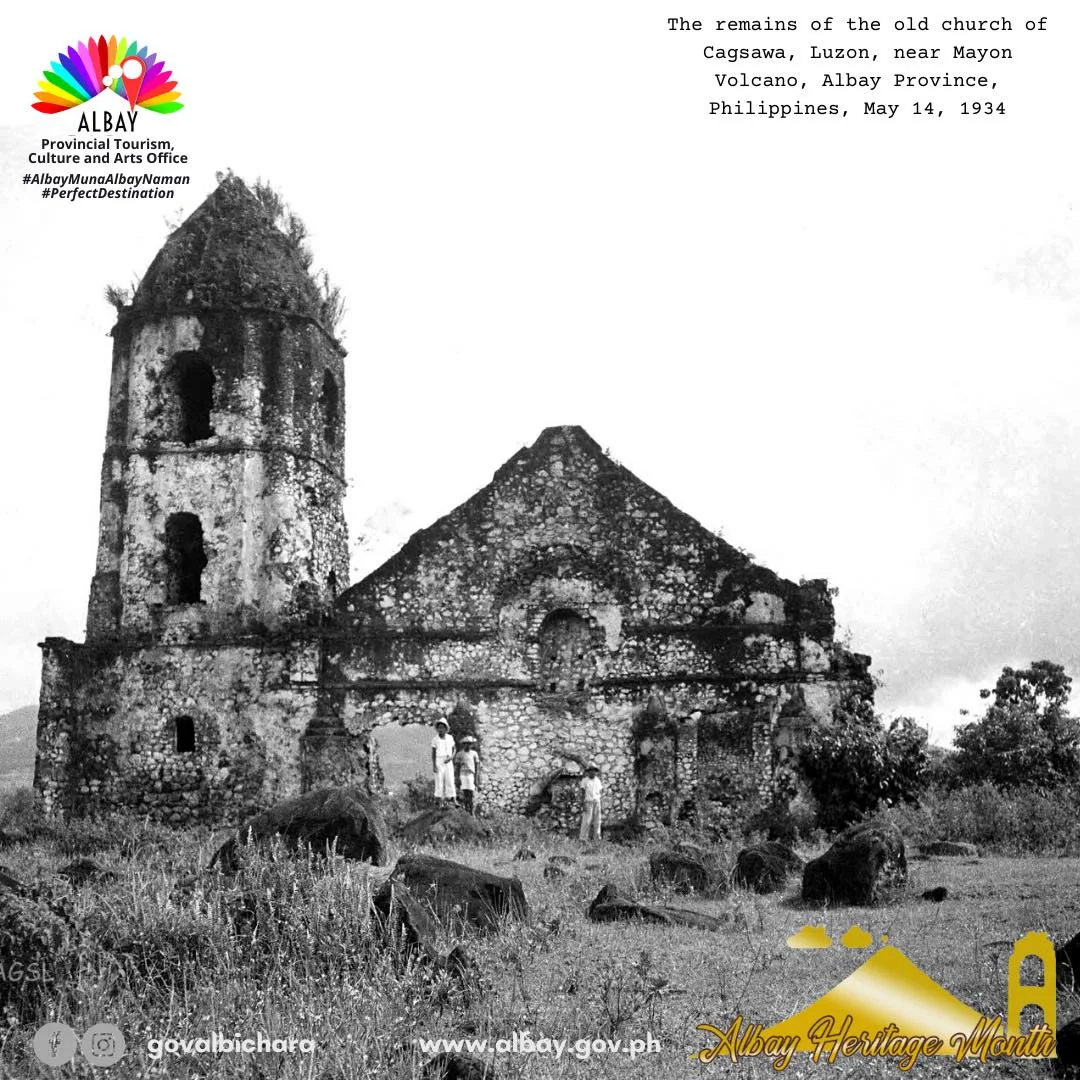


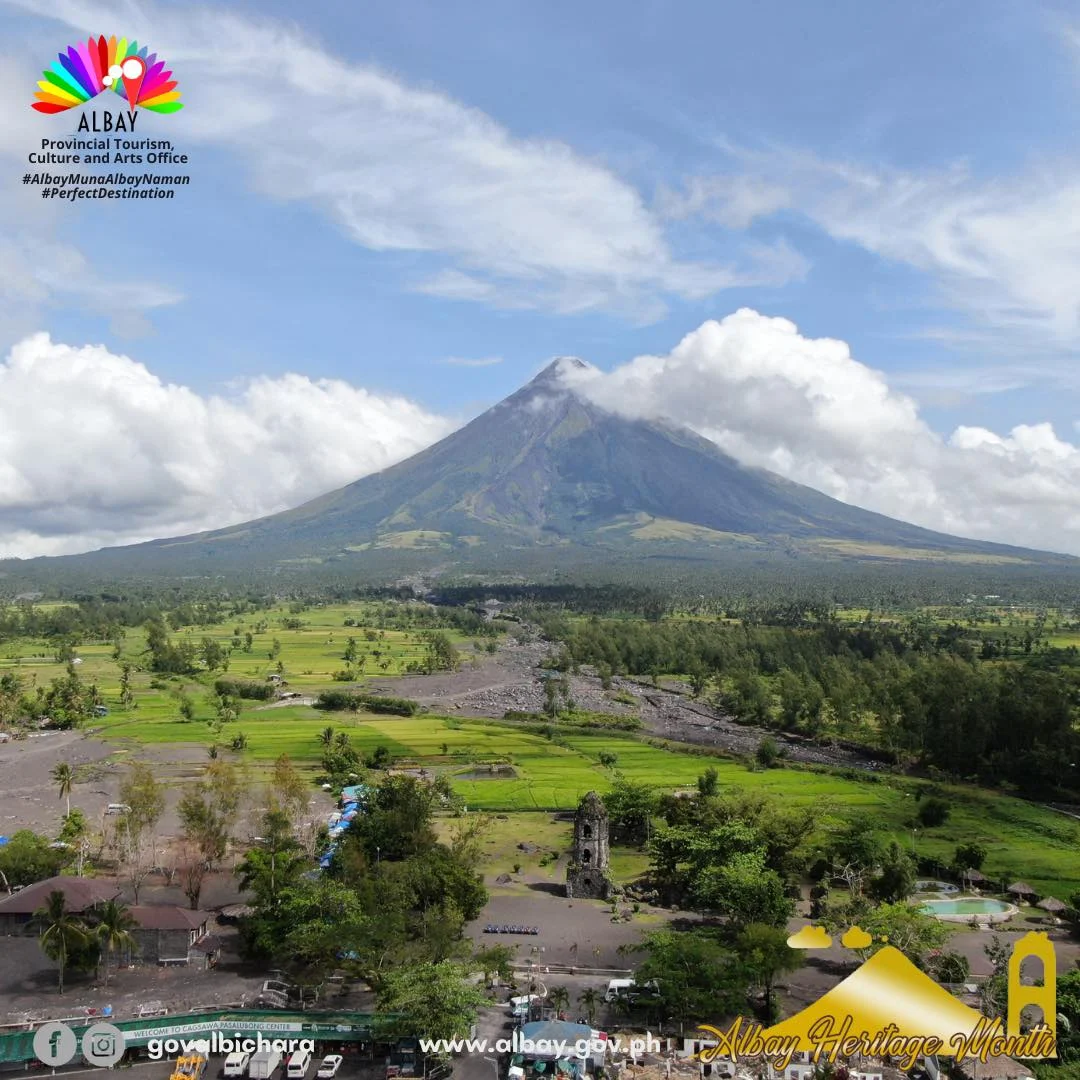






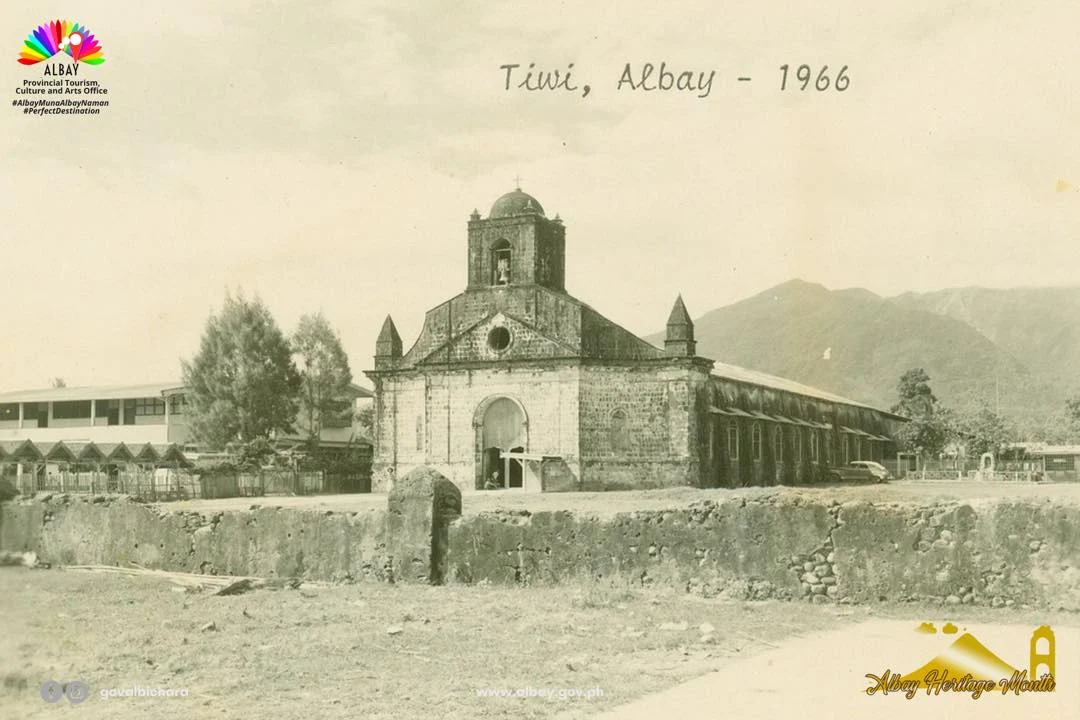

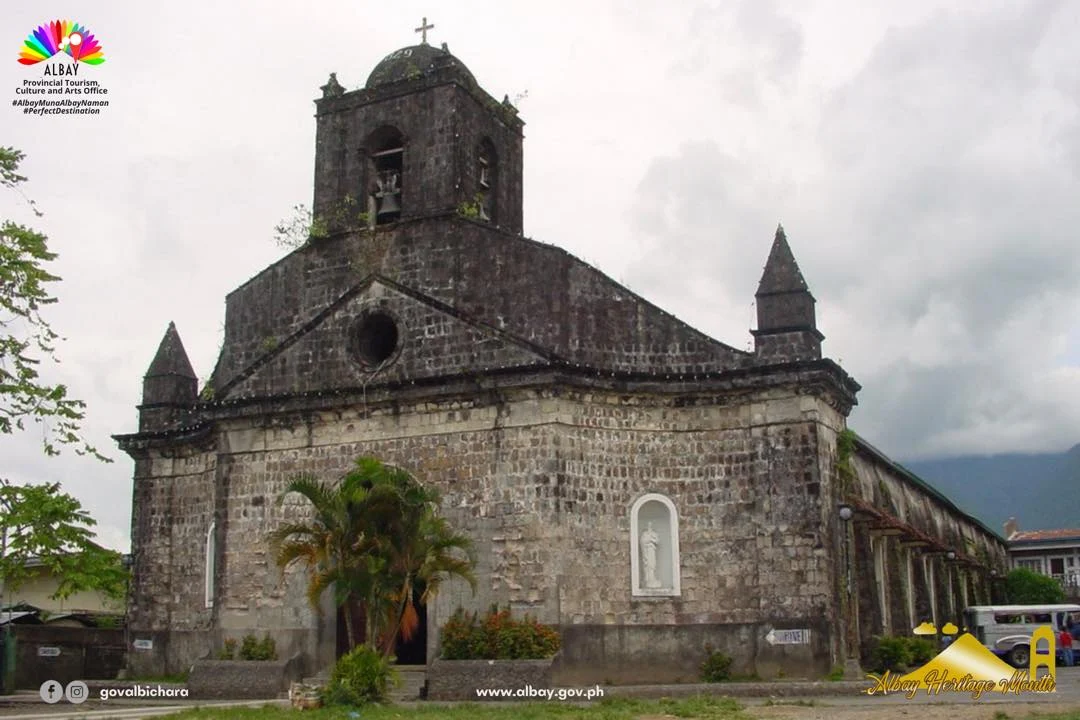

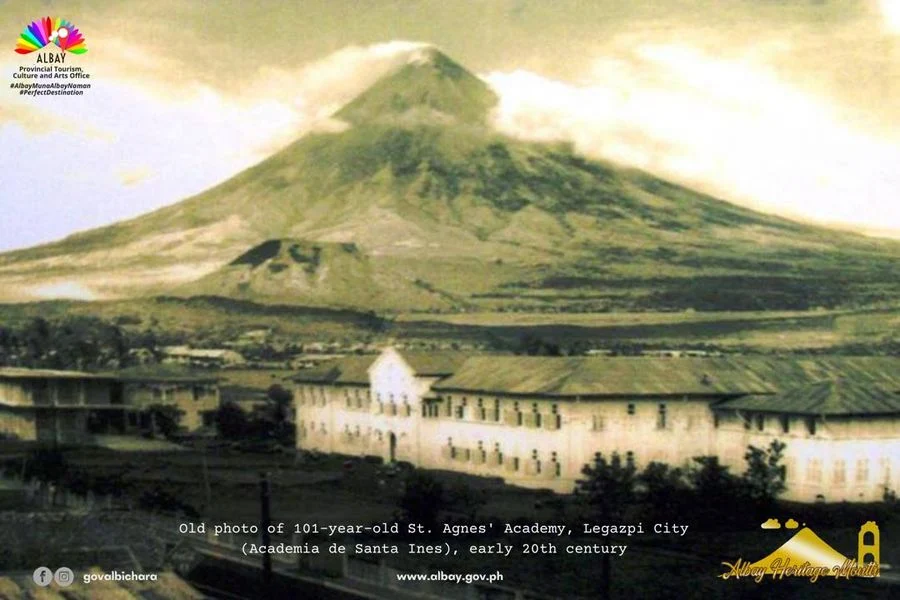



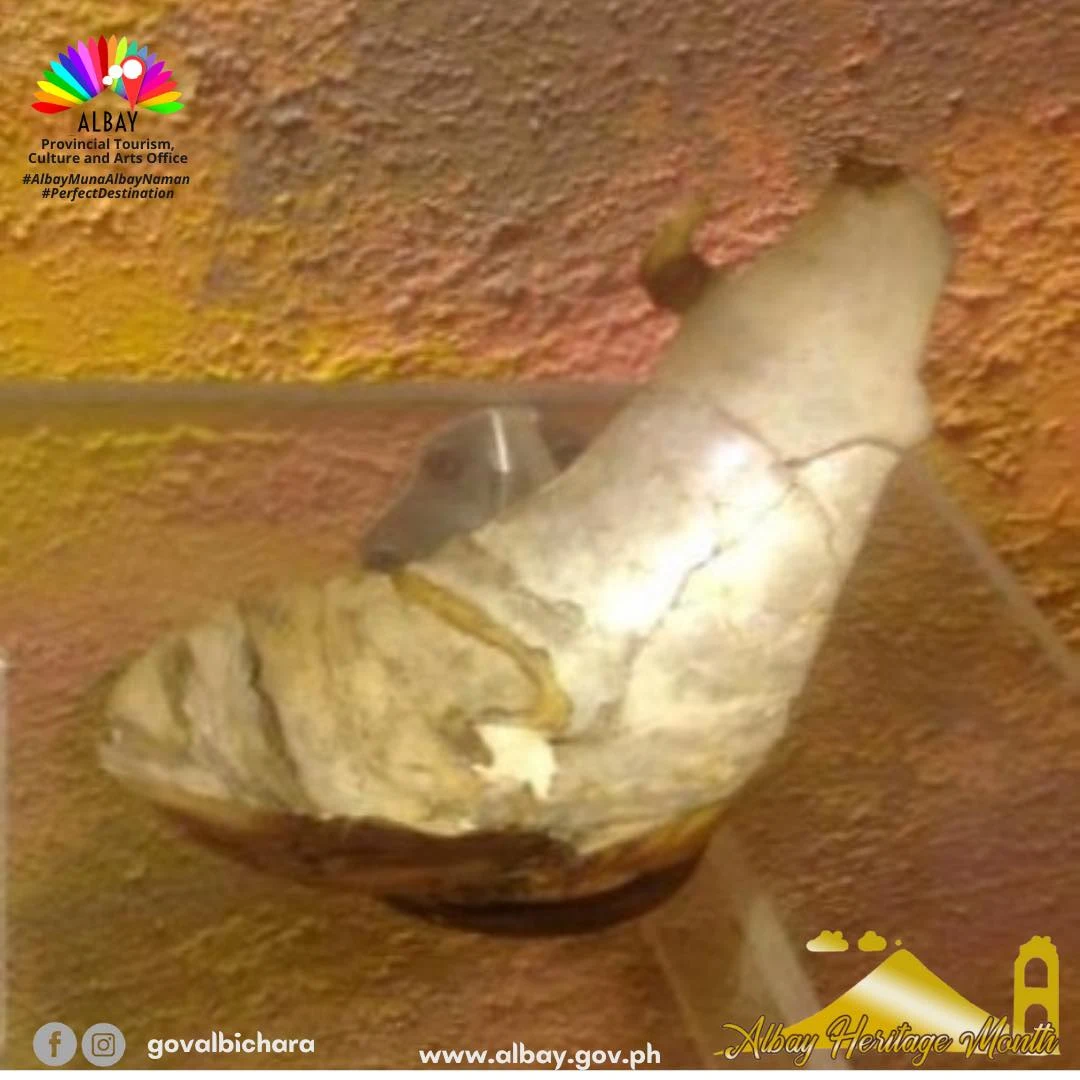

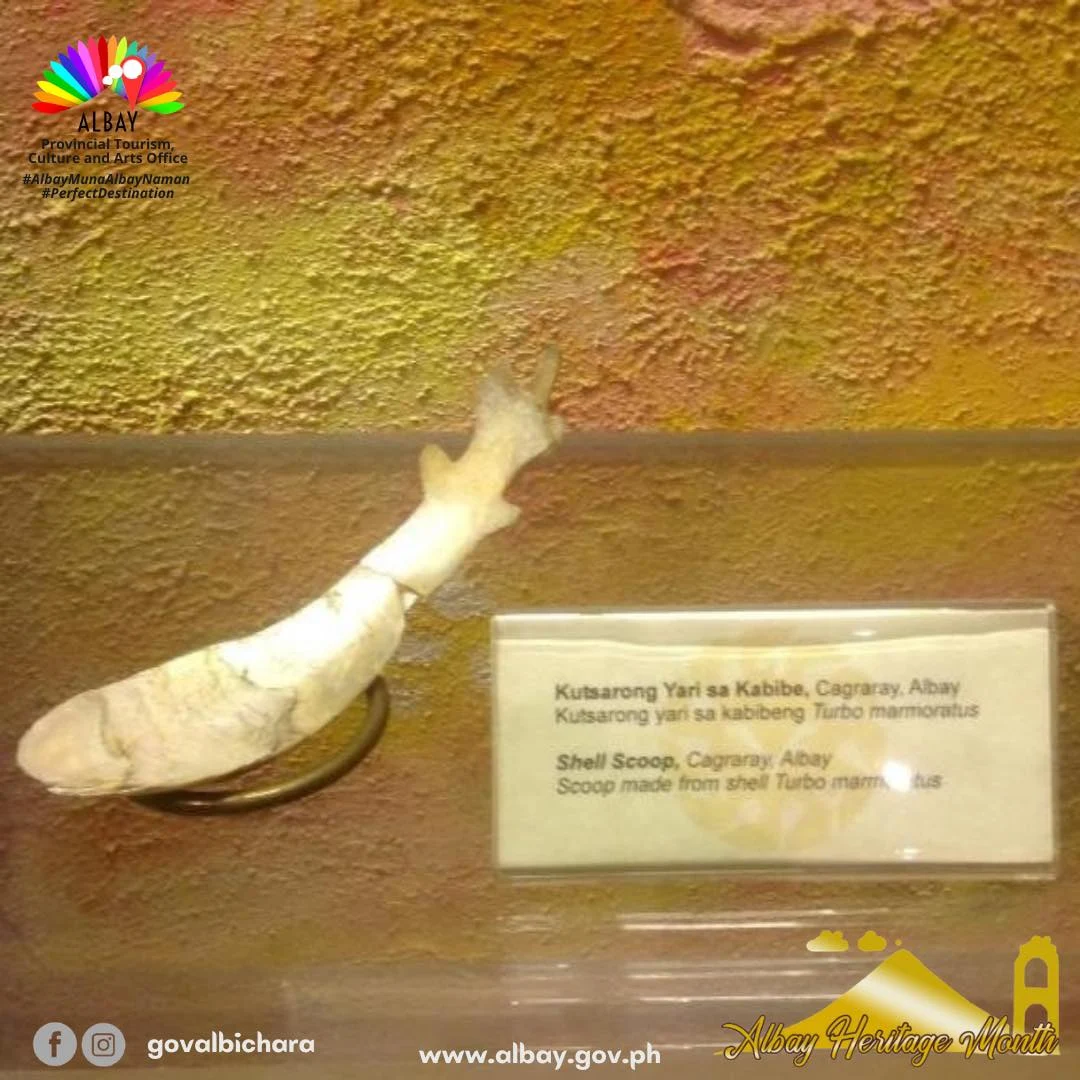



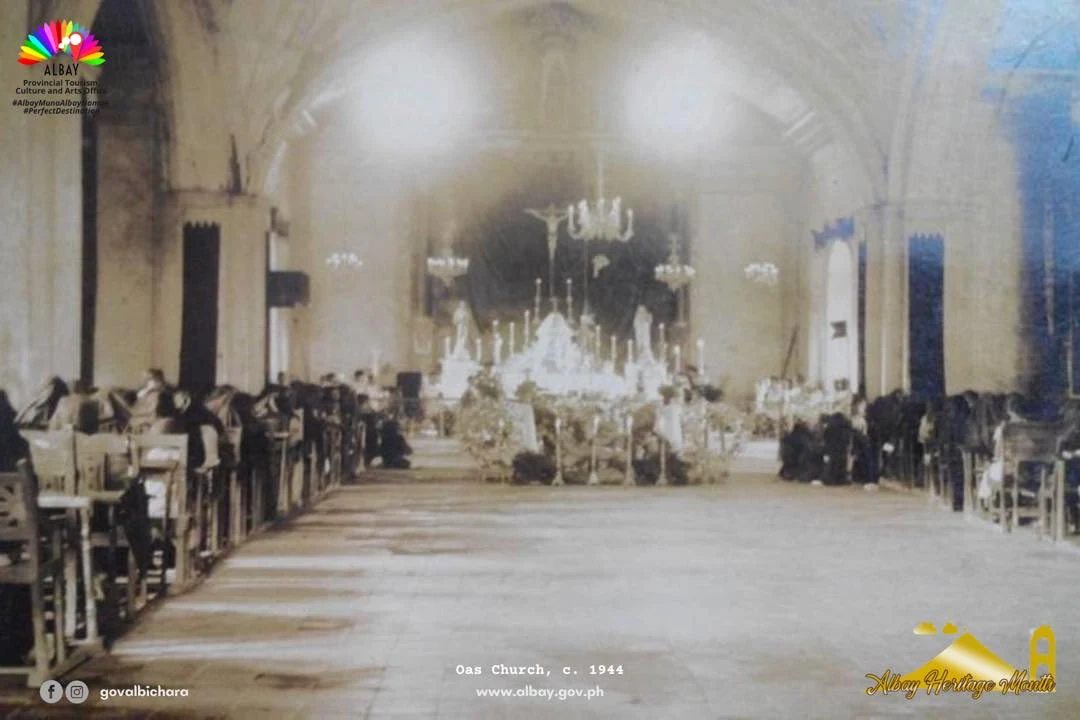






















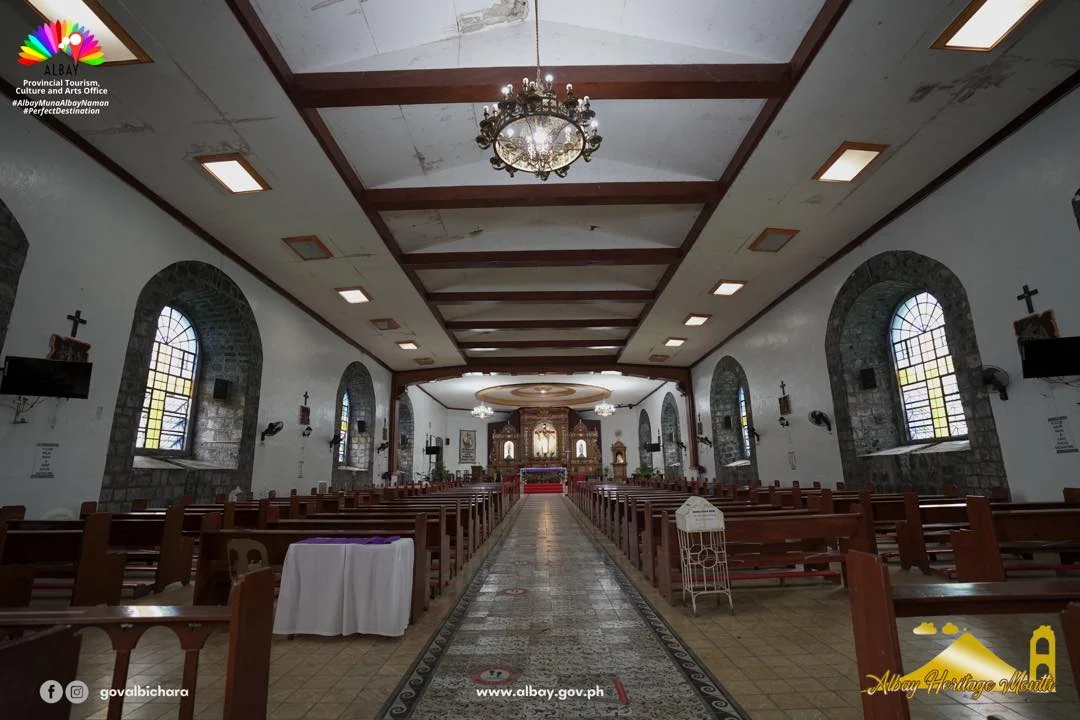









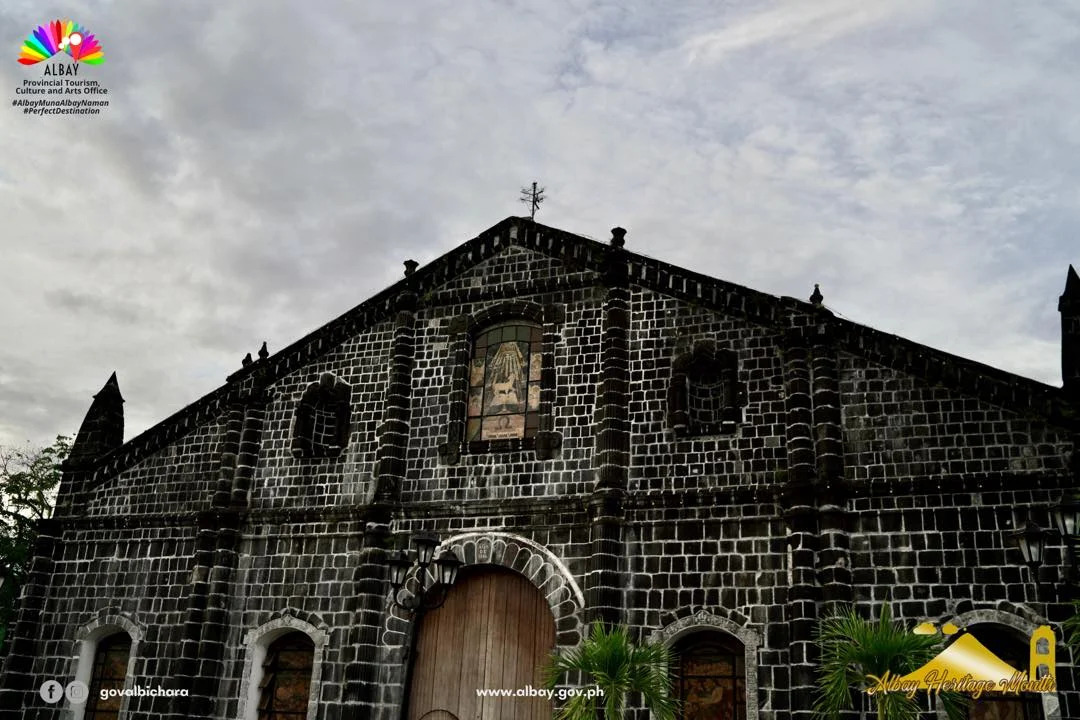

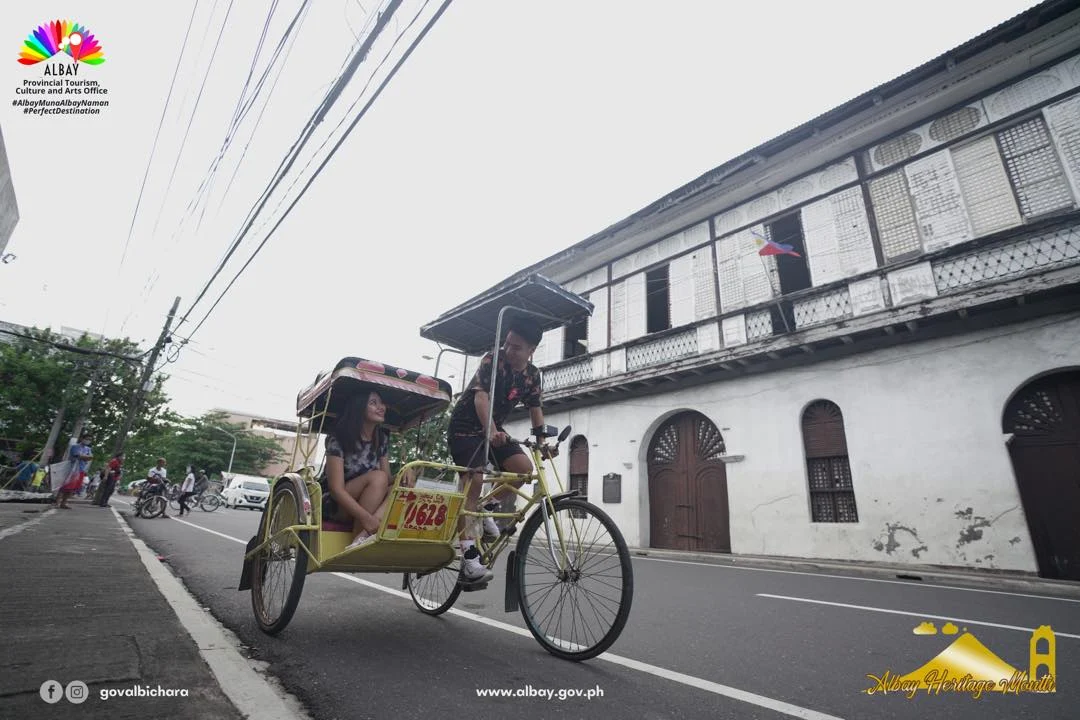
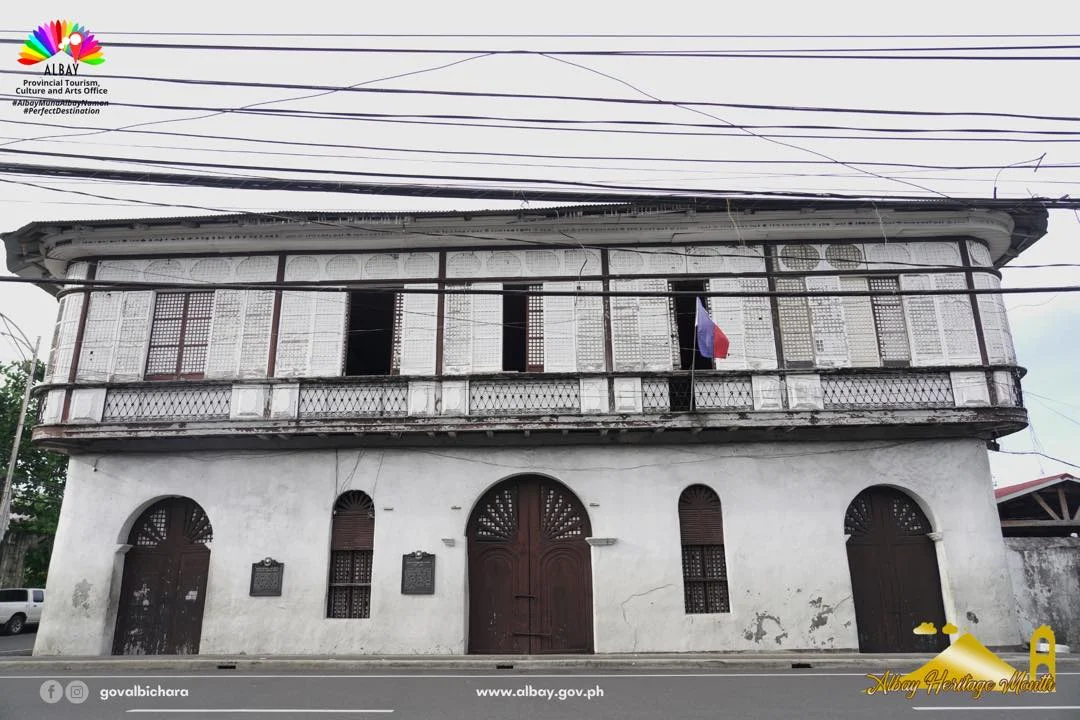










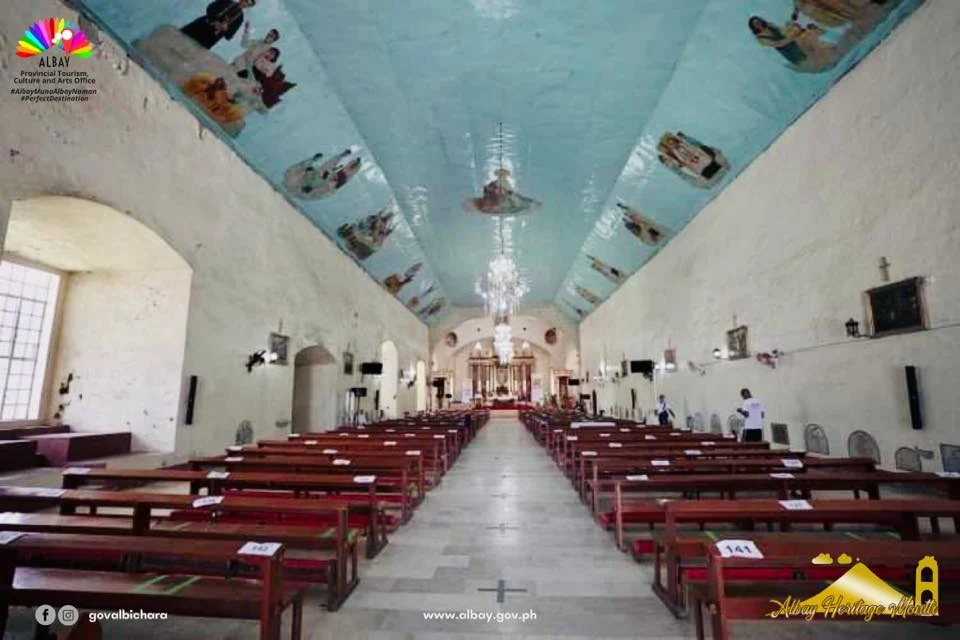



















No comments:
Got Something to Say? Thoughts? Additional Information?